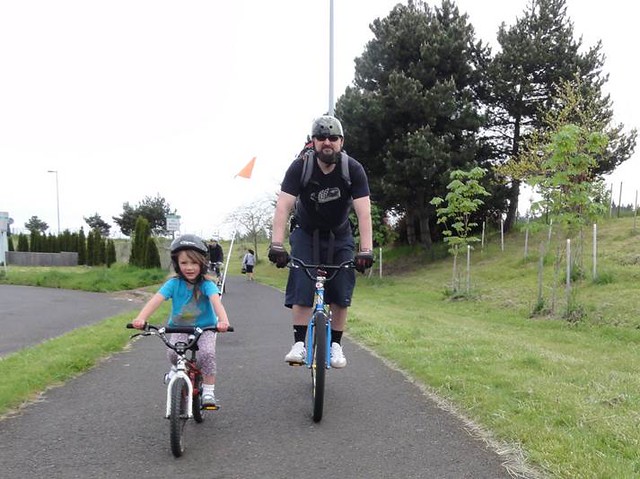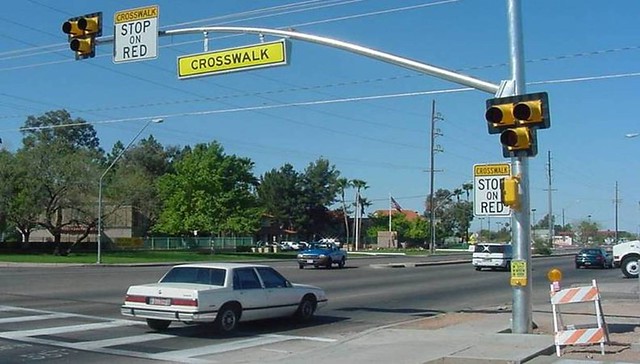A recent survey conducted for the Illinois Bicycle Transportation Plan found that Illinoisans want bikeways that provide physical separation from motor vehicles, and believe these kind of “8-to-80” facilities are a key way to get more people to cycle. Protected bike lanes and bike boulevards, AKA neighborhood greenways, are becoming commonplace in the city of Chicago. Yesterday, the Active Transportation Alliance launched a new project to encourage suburbs to build these types of low-stress bikeways, which are comfortable for people of all ages and abilities.
The Family-Friendly Bikeways campaign will promote the establishment of off-street trails that can be used for transportation, on-street protected lanes, and bike boulevards on quiet side streets, with infrastructure that discourages speeding and cut-through traffic. “For the last 20 years or so, bike planning has been focused on the so-called ‘strong and fearless’ riders,” said Active Trans director Ron Burke. “That was OK, because there wasn’t political will to do more at the time, so it made sense to focus on low-hanging fruit.” However, he noted that studies show less than ten percent of the population feels comfortable cycling on streets with no bike accommodations or conventional bike lanes.
While the region now has hundreds of miles of bike facilities, the lion’s share of the on-street bikeways are conventional lanes or shared-lane markings, which do little to encourage less confident riders to bike for transportation. Off-street trails tend to be loops through forest preserves, which aren’t particularly useful for getting to destinations, and are often challenging to access without strapping your bike to a car rack.
“Part of the evolution of the bike movement is for towns to say, yes, we want to create bike facilities for everyone, not just install some route signs or sharrows,” Burke said. He added that this isn’t such a heavy lift, because most of the suburbs Active Trans works with have already embraced the goal. “When you ask them if they’d be interested in creating a network of bikeways where even a little kid could ride, they say, yes, that would be awesome. It’s more about making a plan for moving forward.”
Active Trans has already been advising suburbs on creating bike plans, as well as coaching them on securing cash for the projects. “We recognize that funding is a big issue,” Burke said. “Even though bike facilities are relatively inexpensive, there’s a limited pot of money for these projects.” He noted that the state recently turned down a joint application by Chicago, Evanston and Oak Park for funding to expand Divvy into the ‘burbs. “Even if towns have the desire to do these things, they may not know how to get the cash.”
Bike boulevards will be an important part of Active Trans’ suburban strategy. “A lot of bike plans feature sharrows on side streets,” Burke said. “You don’t have to do a lot more to create bike boulevards.” Features like contraflow bike lanes, traffic diverters, and traffic calming, which allow continuous, two-way bike traffic but discourage drivers from speeding and shortcutting through residential streets, are relatively easy and low-cost, he said.
While many older suburbs already have a good network of quiet side streets that are comfortable for riding, it can be dangerous to cross major streets at unsignalized intersections. Treatments like refuge islands, raised crosswalks, and HAWK signals allow people to safely make these crossings without having to detour. “Obvious, if we’re talking about a state road with 55 mph speeds, you might need something different like an overpass or an underpass,” Burke said.
There’s already a significant amount of movement towards creating more bikeable suburbs. Evanston is well on its way to creating a network of protected lanes, and is currently updating its bike plan, although the city has floated the possibility of banning bikes from some downtown streets. Blue Island recently adopted a resolution to create family-friendly bikeways.
Active Trans recently met with Highland Park city staff to brainstorm, and they’re working with Oak Park to refine its existing bike plan, which will likely include new bike boulevards. “I’m really excited about that,” said Burke, who lives in the western suburb. “If we can make it happen in Oak Park, I envision a lot more biking.”
Active Trans has a petition on its website that you can sign to endorse the campaign. “The petition is so that, when we’re chatting with towns, and perhaps the state legislature, we can hold up all those signatures and demonstrate that there’s support for this.”







